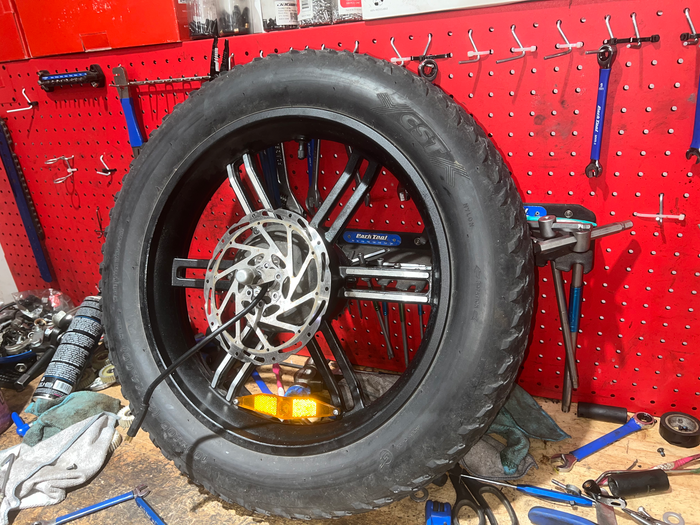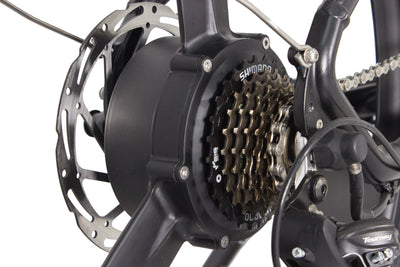Whether you're buying your first e-bike or upgrading your current ride, understanding the motor is essential. The motor affects not only how fast you go but how far, how smoothly, and how safely. In this guide, we break down everything—from types and specs to real-world use cases—to help you choose the right electric bike motor for your needs.
What is an Electric Bike Motor and How Does It Work?
An electric bike motor converts battery power into motion. It's what turns your pedal strokes—or your thumb on the throttle—into real forward momentum.
-
Pedal assist (PAS) engages the motor when you pedal.
-
Throttle mode moves the bike forward without pedaling.
Motors are powered by batteries measured in volts (V) and amp-hours (Ah). Volts represent power. Amp-hours represent range. A 48V 25Ah battery, for example, provides strong output and long mileage—especially with a lightweight frame like the Movin Tempo.
Which Motor Type Should You Choose?
E-bike motors fall into three main categories. Each suits a different type of rider.
Central-Drive Motors
Located between the pedals. Directly powers the cranks.
-
Pros: Smooth acceleration, great hill climbing, balanced handling.
-
Cons: Expensive, complex to maintain.
Rear-Hub Direct-Drive Motors
Built into the rear wheel hub. The motor casing spins around a stationary shaft.
-
Pros: Quiet, durable, minimal maintenance.
-
Cons: Heavier, slower acceleration, rear-heavy ride.
Geared Hub Motors (Used in Movin' Ebikes)
Located in front or rear hub. Uses internal gears to boost torque.
-
Pros: Compact, light, high torque for climbing.
-
Cons: Slightly more moving parts, moderate top speed.
The table compares placement, efficiency, power, and maintenance across all three motor types.
|
Feature |
Central-Drive Motors |
Rear-Hub Direct-Drive |
Geared Hub Motors |
|
Placement |
Center (crank arms) |
Rear wheel |
Front or rear hub |
|
Mechanism |
Torque via chainring |
Hub rotation around shaft |
Internal geared reduction |
|
Efficiency |
High |
Moderate |
Moderate |
|
Power Delivery |
Smooth & consistent |
Consistent high power |
High torque, lower speed |
|
Ride Balance |
Balanced |
Rear-heavy |
Balanced |
|
Noise Level |
Moderate |
Quiet |
Moderate |
|
Maintenance |
Complex & costly |
Simple |
Easy |
|
Acceleration |
Smooth |
Slower |
Quick |
|
Pedal Resistance |
Minimal |
Noticeable drag |
Minimal |
|
Weight |
Balanced |
Heavy |
Light |
|
Cost |
High |
Moderate |
Low |
Infographic: Torque vs Speed by Motor Type
As shown in the graphic, geared hub motors like the ones in Movin’ bikes offer the best torque for urban and hilly environments—without compromising too much on speed.

Why Torque and Power Matter
Two specs define your motor’s feel:
-
Torque (Nm): Force that turns the wheel. Important for hills and loads.
-
Power (W): Calculated as Torque × RPM. Determines acceleration and speed.
"Torque is the most important metric for stop-and-go city riding."
— Canadian Urban Mobility Research Lab (UMRL)
Movin’s 500W (rated) / 900W (peak) Bafang motor hits the sweet spot: legal in Canada, yet powerful enough for cargo, hills, and long rides.
How Fast Can an E-Bike Go Legally in Canada?
Electric bicycles fall into four legal categories:
-
Class 1: Up to 32 km/h (20 mph), PAS only. No throttle.
-
Class 2: Up to 32 km/h, PAS + throttle.
-
Class 3: Up to 45 km/h (28 mph), usually PAS only.
-
Class 4: 750W+ or no speed limit. Often classified as mopeds. May require a license.
“In Ontario, only Class 1 and 2 are legal on bike lanes.”
— Transport Canada Guidelines on Power-Assisted Bicycles
Movin’s Pulse and Tempo models fall into Class 2, making them both versatile and road-legal.
Bafang Motors: A Smart Choice for Canadians
We use Bafang hub motors on all Movin’ models—and for good reason:
-
High torque for Canadian hills
-
Quiet operation, great for city riding
-
Reprogrammable to fine-tune your ride
-
Affordable: Quality motors starting at ~$500
-
Reliable with widely available spare parts
“Bafang motors balance price, power, and performance better than almost any other system on the market.”
— e-Mobility Canada Technical Review
How to Make an Electric Bike Faster (Legally)
Looking for more speed without voiding your warranty?
-
Use higher PAS levels or upgrade to a larger battery (Ah).
-
Keep your tire pressure optimal.
-
Reduce excess weight.
Avoid unlocking or reprogramming your motor’s top speed unless it complies with local Canadian laws. This can disqualify your bike from insurance or trail access.
Maintenance Checklist for Your Ebike Motor
|
Task |
Description |
Frequency |
|
Visual Inspection |
Look for damage or leaks |
Monthly |
|
Battery Check |
Test charge and capacity |
Monthly |
|
Housing Cleaning |
Wipe dirt from casing |
Quarterly |
|
Cable Inspection |
Check connectors and wiring |
Quarterly |
|
Firmware Update |
Update if compatible software is available |
Biannually |
|
Full System Check |
Run diagnostics or shop inspection |
Annually |
Regular upkeep ensures your motor performs optimally and avoids costly breakdowns.
Power Ratings: What is "Rated" vs "Peak" Motor Output?
-
Rated Power (W) = Continuous output your motor can handle.
-
Peak Power = Maximum temporary output under load.
Movin’s Bafang motors are rated at 500W, peaking at 900W when climbing or hauling.
Perfect balance between Canadian legal limits and real-world strength.
Final Buying Tips: Matching Motor Type to Your Needs
|
Need |
Recommended Motor Type |
|
Hills / Cargo |
High torque geared hub |
|
Smooth acceleration |
Mid-drive |
|
Quiet city rides |
Rear-hub direct drive |
|
Easy maintenance |
Geared hub |
|
Long range |
Mid-drive or low-power hub |
There is no universal "best electric bike engine"—just the best fit for you.
Choose Smart, Ride Better
Your e-bike motor is more than a number on a label. It’s the heart of your ride. A Bafang-powered Movin’ bike offers:
-
Legal performance
-
Reliable hardware
-
Efficient, quiet rides
-
Support from a Canadian team
Need help? Visit our store at 654 College Street, Toronto or chat with our team online.



